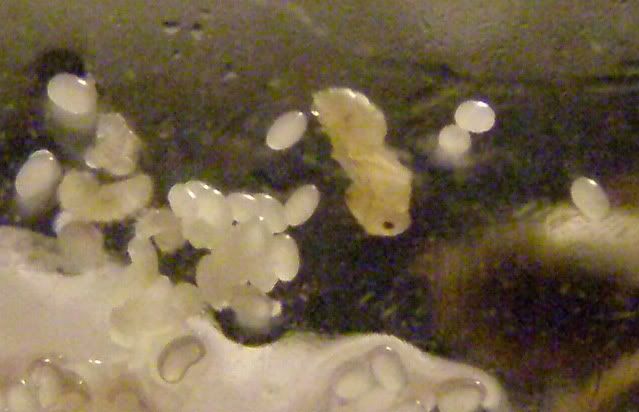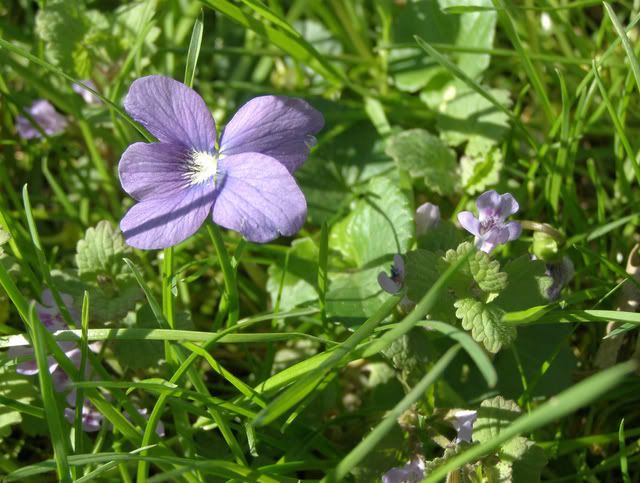
The Prenolepsis imparis queen I caught is so far doing fine. She has a nice cluster of eggs and will probably have some workers in a few weeks. Of course that's still a month or two off.
I'm still finding males to them gathering around lights at night. Nuptial flights are still going on along forested areas and one should keep an eye out for them there in the afternoon hours.

Several queens of Lasius neoniger I caught last August are also doing well. However, I'm having some condensation issues in their tubes and needed to adjust that. I'm trying to figure out a better way to get them to move to a new test tube and allow some sort of ventilation to occur so condensation doesn't become a problem. In the process of fixing this issue I noticed several of their larva did not spin cocoons. And this is an interesting thing the bring up. Wild colonies have access to dirt and flakes of dust (they nest in the ground) and when it comes time for the larva to spin a cocoon for it's final metamorphoses they need a bit of debris to get started. In a test tube setup, among other clean setups, they rarely have this option. Thus captive colonies mostly produce naked pupa and one can gage how tidy the nest is.
Bees
Mason bees have started waking up and I'm thrilled to see their adorable faces. They are completely timid but otherwise shy. I would love to take some close up macro shots of one in action but they always fly away. Hopefully I'll catch a few when more of them emerge though. Their nesting block is still mostly full of cells. (There is a lingering thought that they might all be dead from the refrigirator but we'll see what happens. They normally takes a few weeks to emerge anyhow I'm told.)
Butterflies
The caterpillars on the nectarine tree have completely vanished! It's been windy the past few days and I saw a few entering the flower buds for shelter, while others spun cocoons. While I did notice some unopened flower buds were hollowed out I can't say that I see any on the tree. They remained on one of the weaker side branches of 3 or 5 main ones and I'd say weren't that big of a pest at all (so far). They're either really good at hiding or were eaten by something.
Nature
Well spring is certainly here for most of the country. Garden stores are stocking up on easter plants, but I urdge readers to not get carried away by them. It is the perfect time to buy yourself a fruit tree, berry bushes have a lot to offer, and genarally anything native to your part of the world will be beneficial. I'm thirlled to see Lowes Hardware has more plants labled Native this year and they're even seated on the shelves next to the regular plants too. The benefit that native plants offer is they are useful in far more ways than the nonnative. Most native plants that flower support a pollinator. Plants that are targeted by caterpillars offer food for young birds, weather it's a tree or a sun loving wild flower. Shade wildflowers too have much to offer and many are even distributed by ants as I read in "The Ecology and Evolution of Ant-Plant Interactions."
This book has me inspired to include more plants that are distributed by ants out in the yard.

One plant that has been growing out in the yard for years is the New Jersey State Flower, Viole sororia, pictured above. This is not featured in any of their lists in the book as a plant distributed by ants. But it has me wondering. You see in the past I had wondered if this plant was distributed by ants and located some seeds from one. These are featured on pods very low to the ground, an ideal place for ants to find them. So I gave some seeds to an Aphaenogaster species which didn't care about it. Thanks to reading this book I now know more. One would assume Aphaenogaster would make an ideal seed distributing species for it's nesting in woodland habits here on the east coast. But the thing is Aphaenogaster don't nest near this particular violet out in the yard. Assuming it is being distributed by ants, Aphaenogaster wouldn't be the ideal candidate. Tapinoma, Formica and Lasius however do nest near it though and would make for an idea distributor. I'll have more on this topic in a later post.